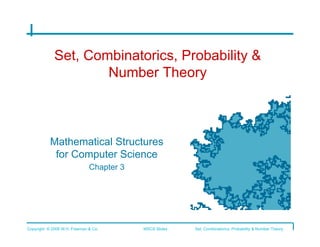
CPSC 125 Ch 3 Sec 2
- 1. Set, Combinatorics, Probability & Number Theory Mathematical Structures for Computer Science Chapter 3 Copyright © 2006 W.H. Freeman & Co. MSCS Slides Set, Combinatorics, Probability & Number Theory
- 2. Counting ● The idea is to find out how many members are present in a finite set. Principles of counting answer the following kind of questions: ■ How many four digit numbers can there be if repetition of numbers are allowed and if repetition of numbers are not allowed? ■ If a man has 4 suits, 8 shirts and 5 ties, how many outfits can he put together? ● Multiplication Principle: If there are n possible outcomes for a first event and m possible outcomes for a second event, then there are n*m possible outcomes for the sequence of two events. ● Hence, from the multiplication principle, it follows that for two sets A and B |A×B| = |A|*|B| ● A child is allowed to choose one jellybean out of two jellybeans, one red and one black, and one gummy bear out of three gummy bears, yellow, green, and white. How many different sets of candy can the child have? Section 3.2 Counting 1
- 3. Example: Multiplication Principle ● There are 2×3=6 or 3×2=6 possible outcomes as seen from the following figures Section 3.2 Counting 2
- 4. Addition Principle ● Addition Principle: If A and B are disjoint events with n and m outcomes, respectively, then the total number of possible outcomes for event “A or B” is n+m. ● If A and B are disjoint sets, then |A ∪ B| = |A| + |B| using the addition principle. ● Prove that if A and B are finite sets then |A-B| = |A| - |A ∩ B| and |A-B| = |A| - |B| if B ⊆ A (A-B) ∪ (A ∩ B) = (A ∩ Bʹ′) ∪ (A ∩ B) = A ∩ (Bʹ′ ∪ B) = A ∩ U = A ● Also, A-B and A ∩ B are disjoint sets, therefore using the addition principle |A| = | (A-B) ∪ (A ∩ B) | = |A-B| + |A ∩ B| ● Hence, |A-B| = |A| - |A ∩ B| ● If B ⊆ A, then A ∩ B = B ● Hence, |A-B| = |A| - |B| Section 3.2 Counting 3
- 5. Decision trees ● Trees that provide the number of outcomes of an event based on a series of possible choices are called decision trees. ● Tony is pitching pennies. Each toss results in heads (H) or tails (T). How many ways can he toss the coin five times without having two heads in a row? ● There are 13 possible outcomes as seen from the tree. Section 3.2 Counting 4
